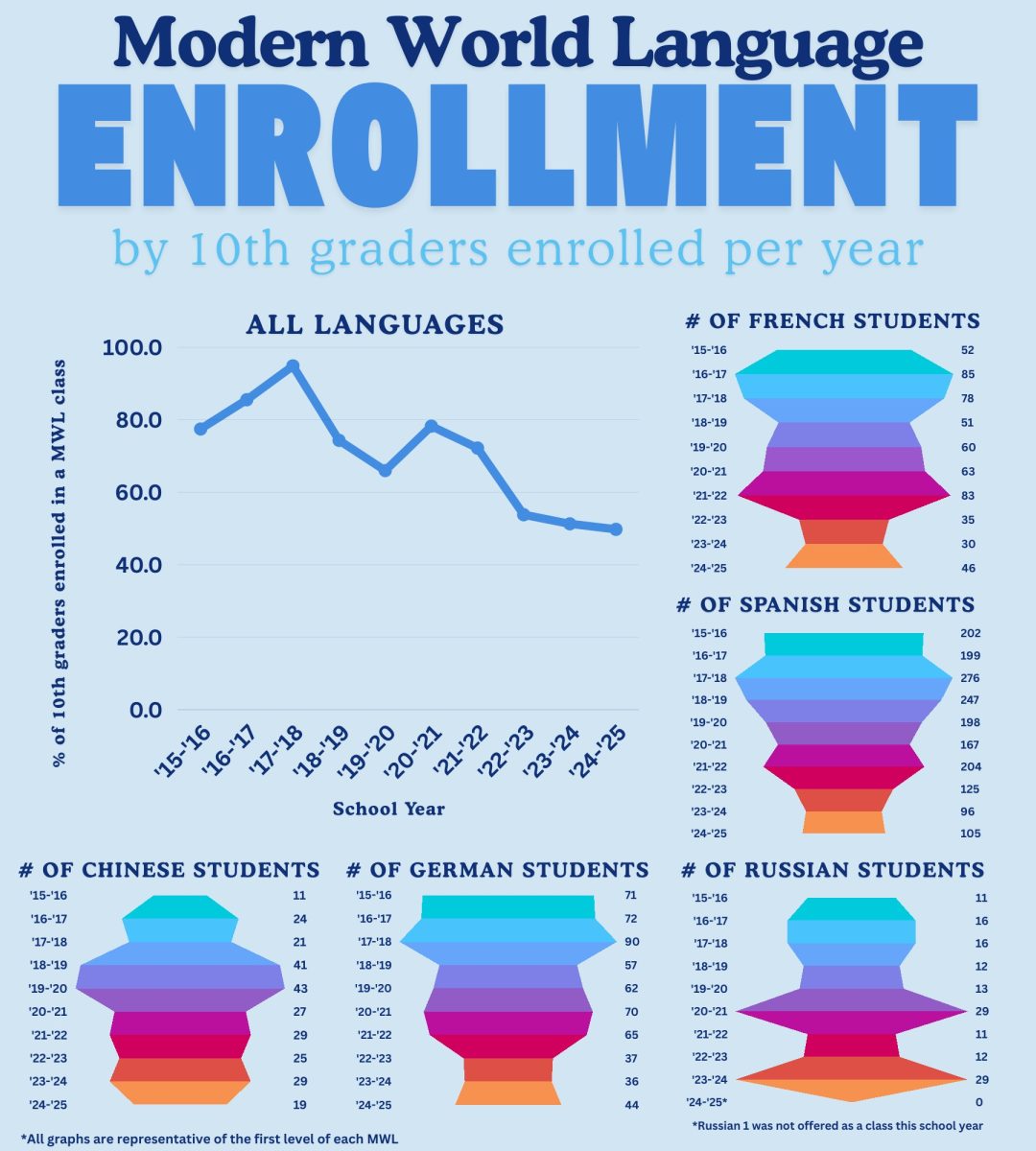In today’s multicultural world, the skill of learning languages isn’t just a useful ability to have; it’s a gateway into various opportunities and cultures.
Due to translation apps becoming a common practice, some have started to question the value of being multilingual.
In evidence of various factors, the population of students at WHHS in a modern world language class has decreased over time.
The New York Times reported that the decline in language education could have harmful impacts on future generations. Because there are fewer options to learn a foreign language in schools, a sharp decrease in interest is likely to follow, causing many people to call for more languages to be taught in schools.
Five modern world languages are offered at WHHS: French, German, Russian, Spanish and Chinese. Each language offers a variety of classes to fit each student’s readiness level. Each course even offers the chance to go on a trip to a country where the language is spoken.
Not only do the classes at WHHS focus on teaching students the ability to speak the language, they also emphasize understanding of cultural contexts and practical application of these languages.
Liz Owens, who has been teaching Spanish for 17 years, including seven years at WHHS, emphasizes the inseparable link between language and culture.
“Culture and language is always one thing. It’s tied together, you can’t separate it,” Owens said. “So as we’re learning to communicate in the target language, kids are also learning about the Spanish-speaking countries like the products that are created, the beliefs, the practices, the perspectives.”
The advantages of being multilingual are helpful even beyond the classroom in real-world scenarios.
”I’ve had several kids that have gotten really hard internships because they’re bilingual,” Owens said. “Like at Children’s I knew a former student, Lydia Knutson, who applied [and got the position]. There were four kids that got the internship and two kids were bilingual. Over any kid in the tri-state.”
Owens also highlights the career potential that comes with knowing a foreign language.
“Each of our languages has a different career focus for certain kids,” Owens said. “The biggest thing is making that known to the kids. It’s letting them know if you’re in music, German is huge. Or with French, what you can do with international business. [It’s important to make] it known what they can do with a language and how it can couple with their personal interests.”
The language teachers at WHHS have been studying and immersing themselves in the languages they teach for years. They foster a love for everything you can get out of a language and prepare students for their future in a globally interconnected world.
Matthew Hurley, head of the language department, has been teaching for nine years, six of which have been at WHHS. Hurley believes using humor and creating a safe environment in his classroom helps his students learn better.
“You have to make students laugh,” Hurley said. “The more relatable the teacher is and maybe the more safety and fun the students are having in class the more they are gonna be engaged. I like to make jokes in the language and try to get the kids to think about it.”
These methods can help students be more comfortable experimenting with the language and making mistakes in the classroom, something that usually makes many students uneasy, but is crucial to the learning process.
Despite the variety of languages offered at WHHS, the department faces many challenges. Teachers are noticing a decline in the amount of students willing to take the extra step and learn a language.
“I think the students that dare to take a modern world language stick with it then they form really close friendships with their peers…,” Johanka Hart-Tompkins, a Russian and German teacher at WHHS, said.
Hart-Tompkins has been teaching for 45 years. She is the only Russian teacher at Walnut but will be retiring next year, leaving a big gap in the modern world language department.
“Hopefully [the decrease in students taking modern world languages] will change in the future because all languages are important. They say you live as many lives as languages. And it gets easier to learn languages the more you know,” Hart-Tompkins said.
Hart-Tompkins also pointed out the practical benefits of learning languages that her students have previously experienced.
“[Students] have told me how they got accepted to Ohio State and got $15,000 scholarships just for having that language and then gone on to do a lot of great things with it,” Hart-Tompkins said. “Kids have told me that they’ve gotten 20 credit hours right away for this language. Then they go to college and have those 20 credits already, then they get to do a double major or minor very quickly.”
The modern world language teachers urge students who are willing to try something new to consider taking a modern world language course.
“If any students are interested to just try taking the first year of a modern language, It’s just really fun,” Hurley said. “They can come and talk to any of the first-year language teachers and we’ll always tell you the positives about it, why they should do it and that we would love to have more students do it.”



